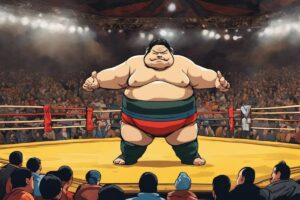Karuta is a Japanese card game that can be enjoyed by people of all ages. In this tutorial, we will teach you how to play karuta.
First, let’s take a look at the basic rules of the game.
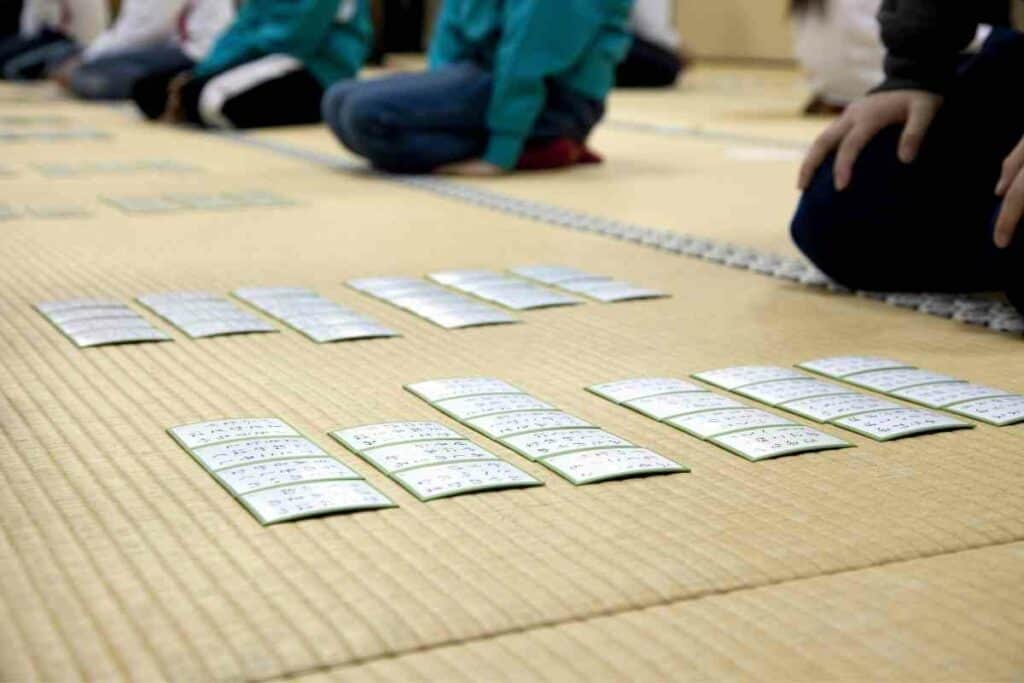
Karuta is played with a deck of 100 cards, which are divided into two sets:
- “Chihayafuru”
- and “Wakatte Ii Yo”
The goal of the game is to collect as many cards as possible by capturing them from your opponent.
The player who captures the most cards at the end of the game wins.
Let’s take a look at some tips for playing karuta.
Table of Contents
A Short History of Karuta
Introduced to Japan by the Portuguese in the middle of the 16th century, Karuta is a deck of playing cards which are very much like a western 52 card deck.
Originally played with shells, it has now become an advanced set of card games of which varying types are played all over Japan.
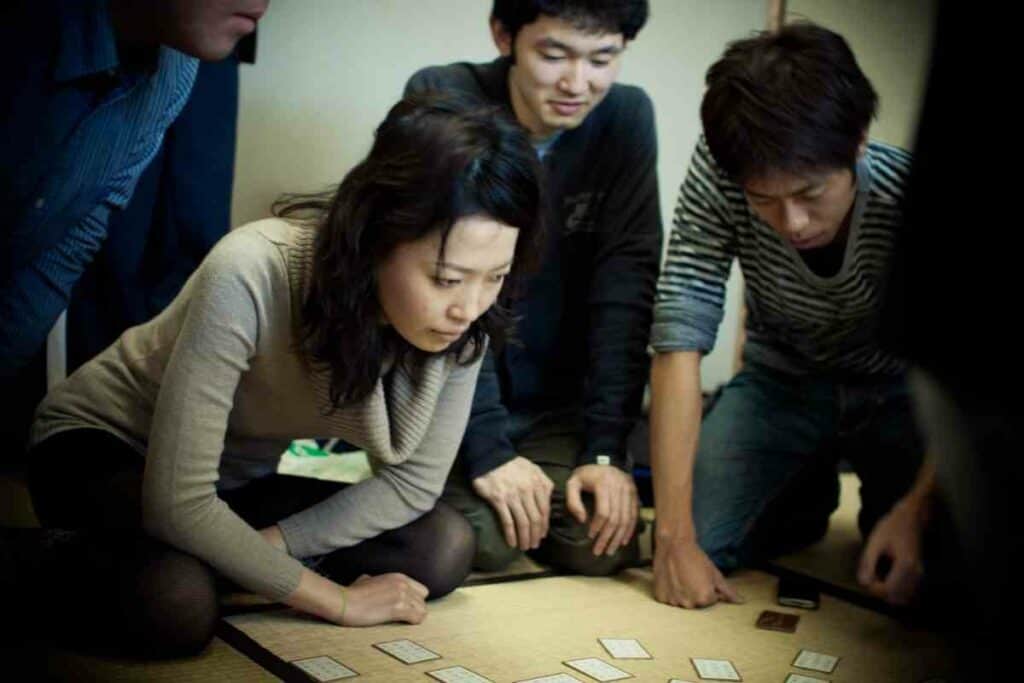
With many adaptations to play, these versatile playing cards can keep you entertained for a good while and have even evolved beyond the confines of the original design.
Some historical decks consist of 75 cards, some even 200, while others are just 40 in total.
With a few variations, some decks even feature poetry which is read out as part of the game.
Booking.comKaruta Today
Not to be confused with the Edo period-specific armour of the same name, Karuta began as a shell matching game.
The inside of clam shells were adorned with pairs of matching artful images. Players would then take turns turning the shells to find matching pairs.
Existing in a number of different forms, today, Karuta is now a Japanese card game which has been adapted and developed over centuries and is a little more complex.
There are two main formats:
- One being ‘Iroha Karuta’ which is considered a simpler variation aimed at younger children and consists of 96 cards (gameplay rules above).
- The second being ‘Uta-Garuta’ which translates as ‘Poem Cards’ and there are 200 cards in this deck.
What Is Karuta?
Karuta is a Japanese card game that has been around for centuries.
The game is played with a deck of cards called “karuta” which are divided into two groups:
- the “torifuda” (the lead cards)
- and the “yomifuda” (the reading cards)
Players take turns flipping over the top card of their torifuda, and then search for the corresponding card in the yomifuda.
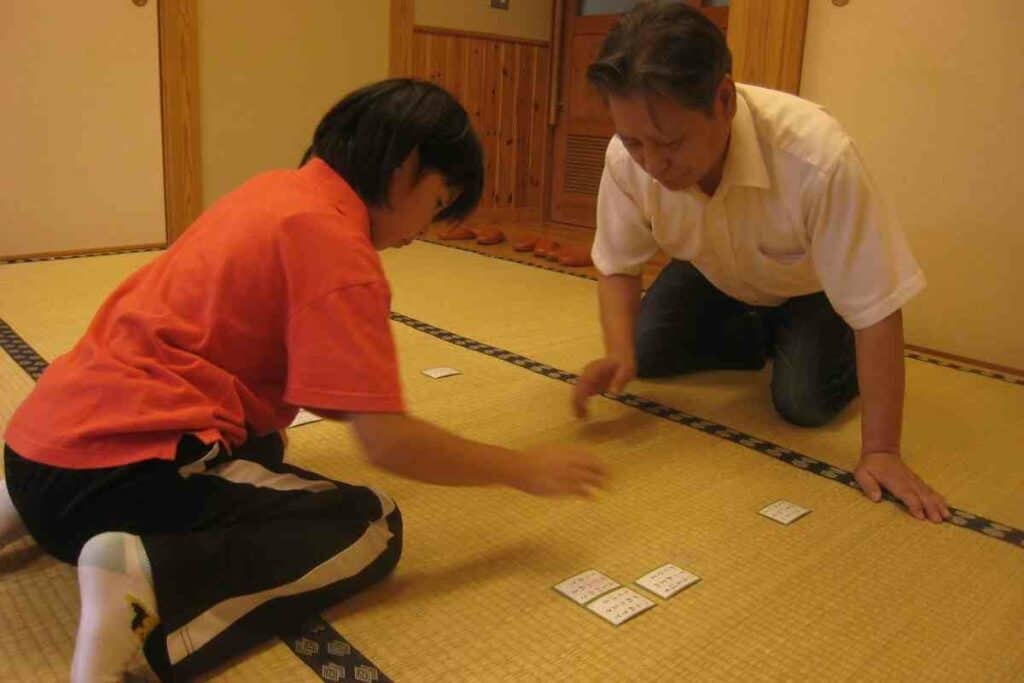
The first player to find and grab the correct card wins the round. The game is played until all of the cards have been matched.
Karuta is a popular game in Japan, and is often played at New Year’s parties and other festive occasions.
The game is also a popular way for children to learn to read and write Japanese.
There are many different kinds of karuta decks, including decks with traditional Japanese characters, animals, plants, and objects.
Some karuta decks even feature Pokemon or other pop culture characters.
What do Karuta cards look like?
Cards vary from place to place and dependent on the period in which they were crafted.
Made to fit in the palm of your hand, Karuta cards are adorned with traditional Japanese images of poets and proverbs, or poetry written by them.
Miniature pieces of art, in their own right, some handmade decks are beautiful to look at.
Some decks are very similar to western 52 card deck of playing cards but there are a few different variations of these to explore.
How to Play Karuta?
Karuta is a Japanese card game that is typically played by two people.
The cards are placed in the center of a square playing area, and each player takes turns flipping over one card at a time.
To play Karuta:
- You will need a deck of Karuta cards and a flat surface on which to place them.
- If you are playing with more than two people, you may want to divide the deck into smaller piles so that each player has an equal chance of winning.
If the player flips over a card with a poem written on it, they must read the poem out loud and then attempt to grab the corresponding card from the playing area.
If they are successful, they keep the card; if not, the other player gets to keep it.
The game is played with two players seated across from each other:
- one player is the reader
- and the other is the listener
The reader recites a poem from memory, while the listener tries to identify which card corresponds to the poem.
The reader can recite the poem at any speed they like, but must not make any mistakes. If the listener makes a mistake, the reader can correct them.
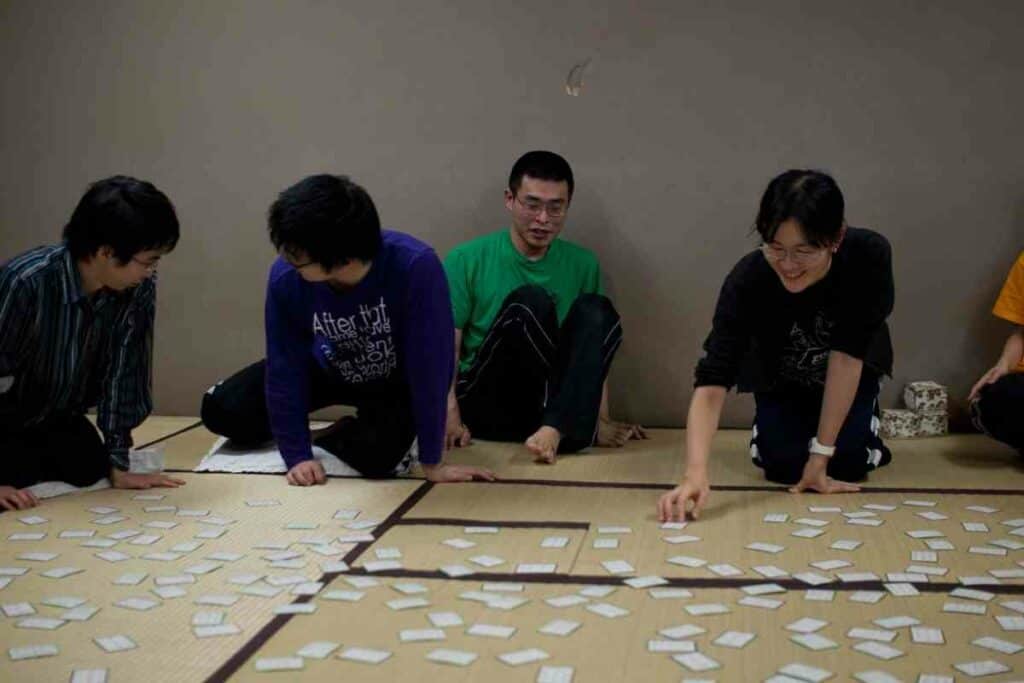
The game is started by the reader reciting the first verse of the poem, followed by the second verse.
The listener then tries to identify which card corresponds to the second verse:
- If they can correctly identify the card, they take it and put it in front of them.
- If they cannot, the reader can give them a hint by reciting the third verse.
The game continues until all of the cards have been correctly identified and taken by the listener.
The first player to collect all of the cards wins the game.
Competitive Karuta
Competitive karuta is played between two players, with each player having a deck of cards.
The game is played in a series of rounds, with each round consisting of two parts:
- the first part is called “reading”
- and the second part is called “drawing”
The most widely played variant of karuta is the Ogura Hyakunin Isshu Karuta, which comes with 200 cards per deck (100 torifuda and 100 yomifuda).
In Competitive Karuta – Two players are split 50-50 for each of 50 randomly drawn torifuda. Each player arranges his or her 25 cards faceup on his or her territory in one of a variety of strategic configurations before the game begins.
A fifteen-minute period is set aside for players to learn the positions of their own (and their opponent’s) cards, followed by a two-minute session for players to practice striking at cards.
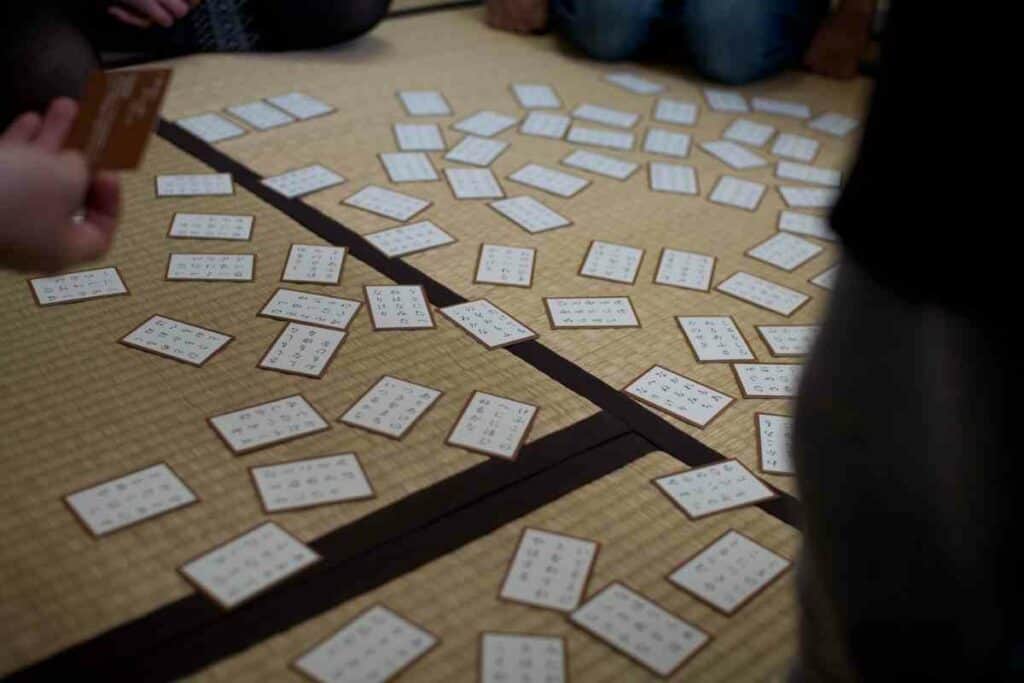
When the timer runs out, the reader starts the game by reciting a poem not found in the Ogura Hyakunin Isshu deck.
The action then begins: the reader sings the first few words of the first poem, while the players try to identify and claim the torifuda card carrying the poem’s final few lines.
- In the reading part, one player reads out a poem from their deck of cards, and the other player must then find and touch the card with the corresponding picture on it. The first player to touch the correct card gets to keep it, and the game then proceeds to the drawing part.
- In the drawing part, each player draws one card from their deck and looks at it. The player with the higher number on their card gets to keep the card, and the game then proceeds to the next round. The winner of the game is the player with the most cards at the end.
Karuta can be played either competitively or cooperatively:
- In cooperative play, both players work together to try to get as many cards as possible
- While in competitive play, each player is trying to get more cards than the other player.
The secrets to learning competitive karuta are remembering all 100 poems and improving hand-eye coordination such that:
- you know exactly which card you need within the first few syllables of the yomifuda
- you can swipe it as soon as you’ve identified it.
What variations of Karuta exist?
At least 9 different types of Karuta cards have existed in two categories:
- The first is known as ‘E-awase’ which are an originally Japanese set of card games which follow the same basic gameplay rules.
- The second category is that of the cards which descended from Portuguese influence and are very much aligned with western card games in the sense that they are often split into suits and contain multiple face cards.
Each E-awase variation does have specific halves, though.
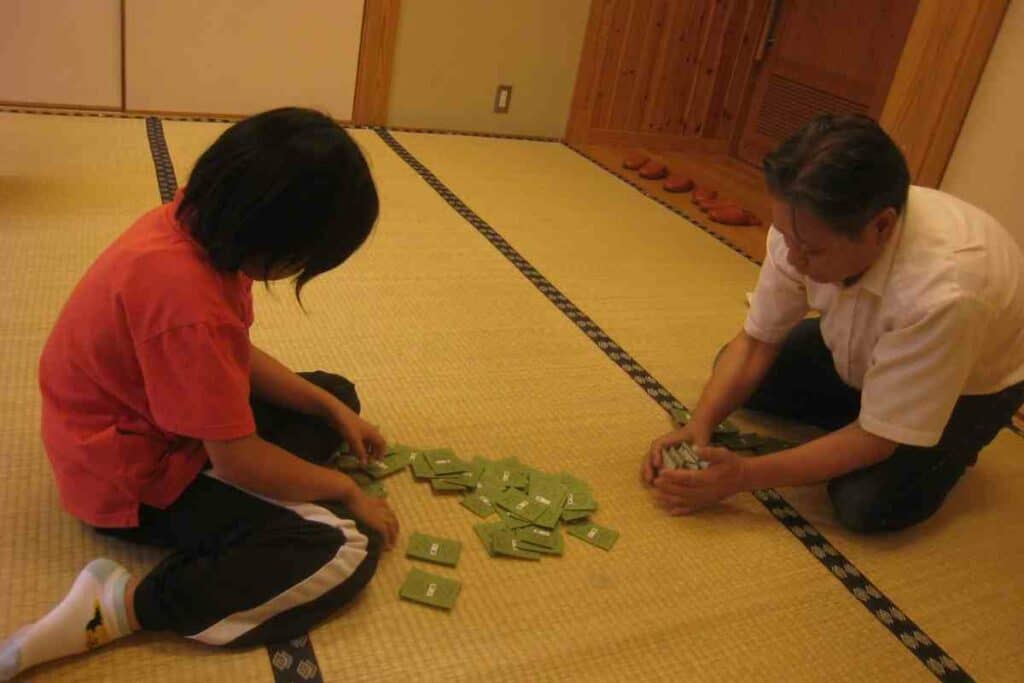
Split evenly into ‘torifuda’ (grabbing) and ‘yomifuda’ (reading).
Let’s take a quick look at some of these Karuta variants
1. Obake Karuta
Beginning with the most rare, this variation of Iroha Karuta is limited to the Tokyo area of Japan and was popular among the city’s population from the Edo period, right up until the early 20th century.
Now pretty much obsolete, it is very unlikely that you will ever see this being played today but it is, nevertheless, a fascinating deck of monsters which holds the roots to mythical creatures like Godzilla.
Documented as one of the initial attempts to name and categorise creatures of myth, we can still see the links within contemporary popular culture to this day.
2. Ihora Karuta
Used as a learning game in Japanese schools, this version is created to both educate and entertain.
Featuring Japanese syllables, it is also a deck worthy of exploration by those starting out learning the Japanese language.
These cards can additionally feature proverbs instead of poetry, which is, again, easier to access for the younger player.
Culturally specific variants of this game: Edo, Owari and Kamigata, exist in isolation of their respective regions and differ in style rather than gameplay.
3. Ita-karuta
A simple deck which was created specifically for the competitive game entitled: ‘shimo-no ku karuta’, this type is made from wood and is somewhat rare: being found mainly in the Hokkaido region of Japan.
A relatively plain variation, words are written in Japanese calligraphy on one side and the other is left blank.
This is not, however, the only competitive form. A quick search on YouTube and you will find some examples of fiercely competitive games in which gameplay can become very intense.
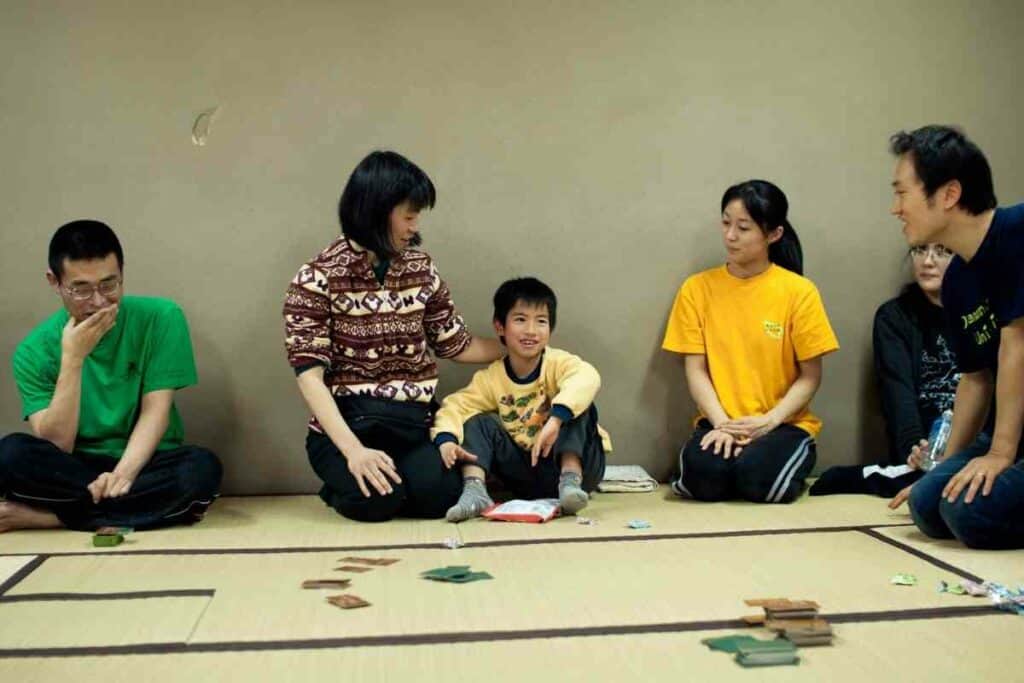
4. Uta-garuta
The most recently established and commonly played of the E-awase Karuta, this variant consists of a deck of a two hundred cards.
A hundred torifuda and an equal amount of yomifuda. Matching cards have a split poem, the torifuda containing just the final few lines.
This game has no changes to the general rules of gameplay (below) and has been a traditional Japanese New Year’s day game for the family, since the early years of the 20th century.
Read later – 10 Best New Year Celebrations In Japan
There are a small amount of additional games which are played with this set – not based in pair-matching.
These use a focus on the images of the poets themselves and do not utilise the whole deck.
5. Hanafuda
Being derived from the Portuguese game, this 48 card deck is known generally as the ‘flower cards’ set.
Originating in the 19th century, these cards differ somewhat from other sets. Rather than being divided into suits of four, they are divided by the number of months in a year.
They can be adorned with animals, objects or even birds. Like western decks, they are used to play a number of games which include a well-known game called ‘Koi-Koi’.
6. Kabufuda
A 40 card deck of 4 identical sets of cards: 4 per number, from numbers 1 to 10.
There is a singular set of face cards for the 10s (Jacks) and these comprise a deck used mostly for gambling.
A popular game is called Oicho-Kabu and because they are so similar to western decks, it is reasonable to presume that there are many more games which can be played with this one.
7. Unsun Karuta
A variation of Karuta which contains a deck of 75 cards, this was established and developed in the latter half of the 1800s.
100 years before the opening of a modest Karuta card company with the name ‘Nintendo’ (Yes, that same multibillion dollar company…), Unsun Karuta is likely the most complex Karuta deck of all.
With five suits in the deck it is an archaic form which would be considered an antique these days and is a far cry from contemporary decks.
8. Komatsufuda
The original Japanese Karuta deck, these cards were adapted from the Portuguese playing cards of the Tensho period (1573-1592) and were even banned due to their political influence in a time when Japan was headed towards global isolation.
Craftsmen and manufacturers were forced to drop Latin influences (suits including: swords, clubs, cups and coins).
This game has all but been lost in the passage of time but some rare decks can be found.
How Long Does a Game of Karuta Take?
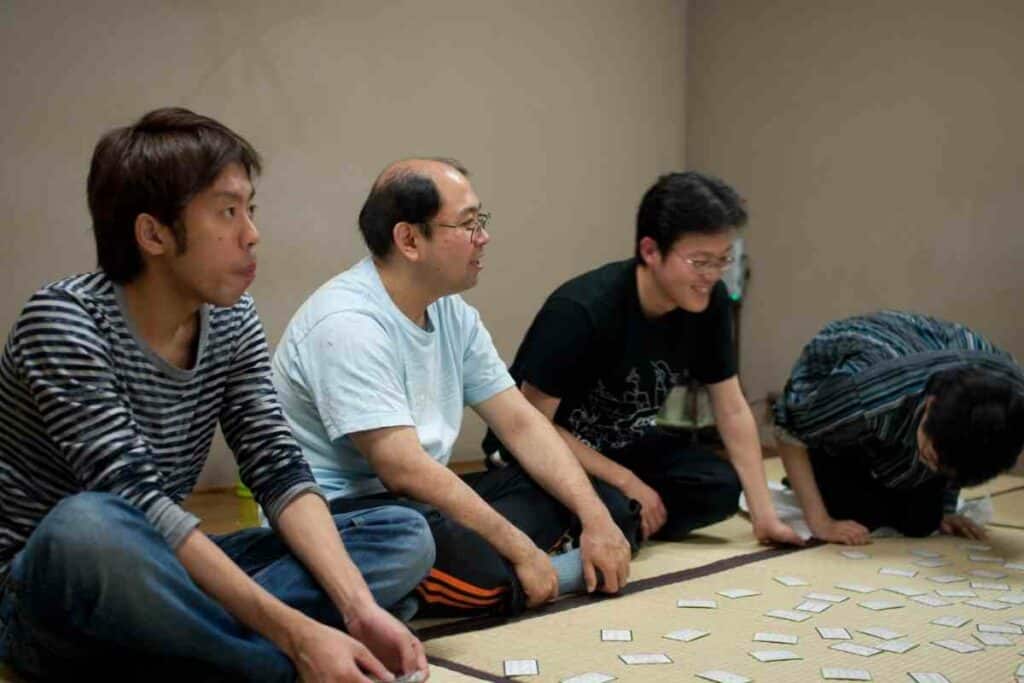
The typical length of a karuta game is 90 minutes, with a 15-minute pre-match memorization period. In national tournaments, the winner typically plays 5 to 7 games.
However, in friendly games between family or friends, the length of the game is often much shorter, sometimes lasting only 20 minutes.
Conclusion
How to Play Karuta? Karuta is a Japanese card game that can be enjoyed by people of all ages.
The objective of the game is to capture cards from a deck that is read aloud by the opponent.
Players must then quickly find and grab the matching card from among a group of pictures displayed on a table in front of them.
Karuta can be played with two or more players.
Relatively unique to Japanese culture, Karuta card games were the founding product of one of the largest video gaming companies on the planet today.
Not just owed to the game’s Nintendo heritage, there are also a number of digital formats of Karuta, available in many app stores in the gaming world.
These are immensely popular in Japan. Arguably, however, there is nothing like the real experience of getting yourself a real deck of Karuta cards and having a game with your friends or family.
With so many variations to choose from, there are even those you can learn from and teach your children.
Read Next
- The Forbidden Japanese Island That Will Give You Nightmares
- Miss Japan Forced to Wear Sailor Moon Costume Since Childhood: Claims It’s the Secret to Her Success
- Essential Guide to Japan VPN: Secure Access and Privacy for Travelers
- Sumo Wrestler Suit for Adults by TOLOCO: Best Sumo Suit?
- Eki Stamp Book (Gotta Collect Them All!)
- Explore the Fascinating World of Japanese Rubik’s Cubes




